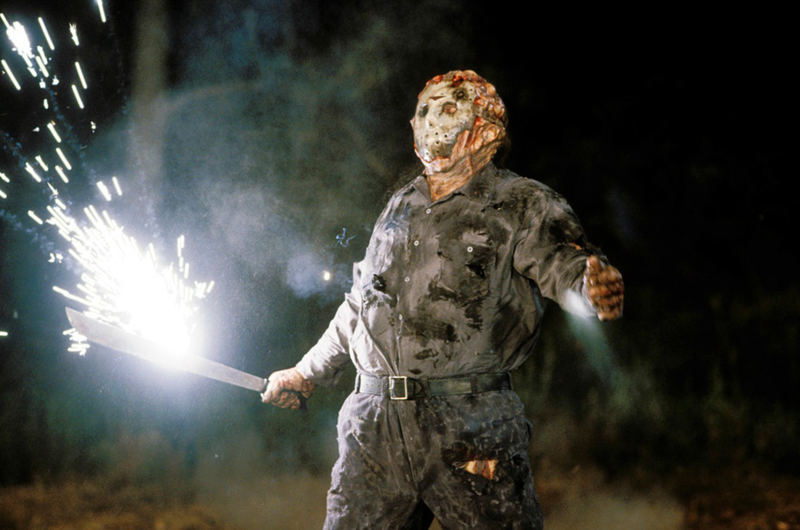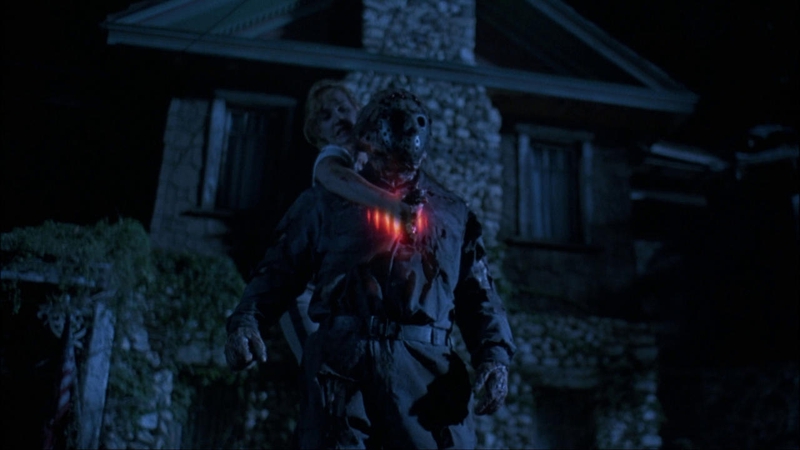A beloved eighties slasher franchise with a committed fanbase prepared to follow its iconic masked villain on another blood-soaked rampage, and what did the nineties do? Blow him to smithereens.
Ah, yes, Jason Goes To Hell: The Final Friday. The 1993 film that posits our favorite hockey mask-wearing slasher is nothing more than a literal turd takes a lurching step into new terrain and succeeds on every front. Make no mistake, this sequel is disinterested in trotting out the same story beats, instead opting for a melange of body horror and ludicrous mythology. Right off the bat – or should that be machete? – it's clear this isn't your typical Friday the 13th movie. The movie opens as the FBI lures Jason into a trap baited with a lone camper, then detonates him. His remains are carted to the morgue, where the coroner, overcome with sudden, unexplained urges, chows down on his black, gooey heart, and embodies the spirit of Jason. The rest of the film follows a string of unlucky souls forced to become vessels for Pamela Voorhees' son as he stalks his last living relatives so that he may be reborn.
This big, brash reinvention doesn't change the Friday the 13th mythos — it molds a new one for a new era that delivers on its intentions which are quite simple: how far can we push the inane? Despite what its detractors might say, Jason Goes To Hell tries its hardest to veer away from the formula cemented by the previous eight entries– Jason (and Pamela and Roy, let's not forget) stalking Crystal Lake campers and other oddbods unfortunately in the wrong place at the wrong time. Jason Goes To Hell doesn't unpick those entries. They still exist, it just drags the franchise into the 1990s.
But why this drastic change? Following the lackluster critical and financial reception of Jason Takes Manhattan, Paramount Pictures wanted to take a breather, but Sean S. Cunningham, one of the franchise's original creators, was keen to push on with a Freddy vs Jason flick. As New Line Cinema owned the rights to Freddy Krueger, they were licensed the rights to Jason. New Line got cold feet about diving straight into a crossover movie, deciding to develop a prequel to that tussle first. The snag? New Line's contract only granted rights to certain components from the first movie; Jason Voorhees, Pamela Voorhees, the camp, and the lake.
That clutch of elements was not the only restriction for the fresh-out-of-film-school, 23-year-old director Adam Marcus. The hockey mask proved a point of contention between Marcus and Cunningham. In fact, a long-standing back and forth still persists about the presence of Jason's signature adornment. According to Marcus in the documentary Crystal Lake Memories and a 2020 interview, Cunningham said, "If you can figure out a way to get that f*****g mask out of the movie, I'll let you write and direct the film." Cunningham has since denied this, but regardless of the he-said, she-said, there are mere minutes of hockey-mask Jason in the finished movie.

It's at this point, with hardly any usable components of a Friday the 13th movie at their disposal, that Marcus and screenwriter Dean Lorey pushed the script into a new domain that ultimately led to its iconoclastic nature. As a result, Jason Goes To Hell is a raucous legacy sequel, ignoring the previous seven entries and picking up the first film's parting motif – the zombie Jason boy in the lake. (Interestingly, while researching the role, John LeMay, who plays the antihero, only revisited the first movie, choosing to forgo a marathon of the rest. "I really didn't feel it was necessary to see any of the other seven," he told FANGORIA back in 1993, "because we were trying to do something new here.")
Marcus' primary hurdle was to figure out how Jason was resurrected at the end of Friday the 13th. Without seeking rights – although Marcus and Lorey did visit Sam Raimi during the filming of Army of Darkness to snag a prop – the movie supposes that Pamela Voorhees secured a copy of the infamous flesh-bound tome from the Evil Dead franchise, the Necronomicon, to bring her beloved son back to life. According to Marcus, her attempt is successful, but she doesn't realize it. "When his mother is decapitated at the end of Part 1, that's when Jason comes up for air for the first time. He is now… a Deadite, or something the Necronomicon was able to resurrect. Suddenly no rules apply to his character."
This tactic feels intentionally designed to elicit eye-rolls because of how far-fetched it sounds, yet this meta-approach to Jason's revival opened up a world of options. And the ones chosen tickle the toes of eccentricity.
A new mythology is slowly revealed in a manner that implies audiences are already familiar with it, a bold move that irked a lot of hardcore Friday fans. Per this legend, Jason has a sister, a niece, and a stalker, the latter in the form of bounty hunter Creighton Duke played by Steven Williams. Decked out like a cowboy – a costume choice that only lends to the haphazardness – Duke's responses to simple questions are cryptic and silly, and his penchant for spouting exposition is more comical than informative. A simple exchange with Jason's sister, Diana (Erin Gray), in a cafe, portrays him as browbeaten and surly – when she's simply taking his order. Steven (Le May) demands answers about Jason's new-fangled abilities, but Duke only spills after breaking Steven's fingers. You know, for payment. When asked what he imagines when he hears the words "Jason Voorhees," his answer is the stuff of cult movie infamy: "That makes me think of a little girl in a pink dress sticking a hot dog through a doughnut." Marcus attests that this one-liner emerged from one single purpose: "How can we crack each other up?"
Creighton Duke's legacy continues. "In a Voorhees was he born. Through a Voorhees may he be reborn. And only by the hands of a Voorhees will he die. "Where have we heard this critical piece of information before? Nowhere. It's another addition to the lore recited by Duke over and over, like a murderous mantra. Jason can also only be killed by a member of his own family using a specific dagger. Where have we seen this vital instrument before? Nowhere. "He sells this stuff, man," quips Marcus on the film's audio commentary as Williams spouts this unending list of rules to LeMay. "This is pretty tough stuff to sell," adds Lorey before the pair break down into chuckles. "What's he even talking about?" laughs Marcus.
Surrounding Duke is an ensemble of supporting characters who feel plucked from a John Waters film. Rusty Schwimmer, as the cafe owner Joey, is a foul-mouthed opportunist who barks orders at her staff, including Leslie Jordan as her husband Shelby, with whom she spars beautifully. Steven Culp chews the scenery as douchebag reporter Robert Campbell. The movie's star-crossed pair, LeMay and Kari Keegan, as Jason's niece Jessica, generate believable chemistry as a once-happy couple trying to stop a zombie slug from embodying their child.

What's made clear with every rewatch is that Jason Goes To Hell, like the rest of the franchise, isn't grasping for prestige. "I hope people know that we made it with our tongue firmly planted in our cheeks," says Marcus. It's not attempting to make a lick of sense, as evidenced by its most peculiar mythology remix of all. The film supposes that this Jason – yes, the one resurrected by Pamela using the Book of the Dead – isn't even a person anymore. He's a mere vessel, his hulking mass a convenient meat suit for a murderous soul slug to inhabit until he dies and needs to escape to a healthy corpse.
The movie's finest achievement is how this metamorphosis is presented on screen. With a hint of Shivers and a dash of The Hidden (which Marcus swears he'd not seen), the practical effects from the skillful KNB EFX team bring this new quirk disgustingly to life, making this arguably the goriest Friday movie to date. When a person's body is deemed unusable by the Jason-slug, it departs, leaving behind a cadaver that doesn't merely decompose. These empty shells sizzle and rot in puddles of pink grue and grime more akin to the splatter sensibilities of Peter Jackson's Dead Alive from the previous year.
The film's commitment to effects across the board is commendable. One sequence shot at the insistence of New Line – who demanded slain campers – features a woman skewered by a spike at the moment of orgasm and then ripped in two. Take that, Beau is Afraid. This involved actress Michelle Clunie sitting for two casts, says KNB's Robert Kurtzmann. One is pummeled with the spike, another torn in half. Jason Goes To Hell's mash of grue and comedy plays like a broad progenitor for the slew of intertextual, meta horrors to come in the mid-'90s. Granted, it doesn't possess an ounce of the subtlety or skill of New Nightmare or Scream, yet its playfulness provides a different, more batshit reward.

A common critique of the movie is that its shortcomings stem solely from hastily introduced, retconned mythology. At the time of the series' inception, no grand vision was plotted out, MCU-style. Each film was greenlit based on the former movie's box office success.
Look to modern horror sequels like Scream (2022), Scream 6, and the Halloween trilogy, and you'll find those same dubious reworkings to beloved horror history. A better comparison—if we draw a contemporary parallel— is to look toward recent studio horrors that have accomplished the same levels of self-awareness as Jason Goes To Hell without the franchise shackles. In the last few years, the likes of M3GAN, Malignant, Old, and Cocaine Bear straddle the borders of self-awareness and the absurd, calibrating perfect horror alchemy.
The goal of this brand of low-culture horror – to which Jason Goes To Hell also distinctly belongs – is to highlight and celebrate the radical of the genre, to point out how it is so separate from our everyday lives. In light of the trauma-informed horror of recent years, from the likes of Ari Aster, Alex Garland, and Robert Eggers, its emphasis on leveraging audience reaction from the weight of palpable, soul-wrenching grief, the schlock of camp offers an alternate horror experience. If, according to a key critical essay on the topic, "the whole point of camp is to dethrone the serious," perhaps the bigger issue is why the absurdity of Jason Goes To Hell is considered its biggest failure. How can you fail to meet standards if the filmmakers had no intentions of reaching them in the first place? If anything, the movie's "spirit of extravagance" (yes, I know, I'm citing Susan Sontag in an article about a Friday the 13th film) is the point of it.
Listening to Marcus and Lorey on the movie's audio commentary, the pair chuckle away at the mayhem unraveling onscreen, almost as surprised as we are to see what they got away with. With no rules and hardly any scraps of the franchise to use, they cooked up a wild ride freed from the pedigree of its predecessors. Audiences who want to visit this bastard child of the franchise would be wise to avoid assigning greater meaning to a movie about a bloated, psychotic worm with a vendetta. Sometimes movies aren't trying to shoot for the stars. Sometimes they're pushing a hotdog through a donut.






